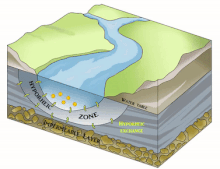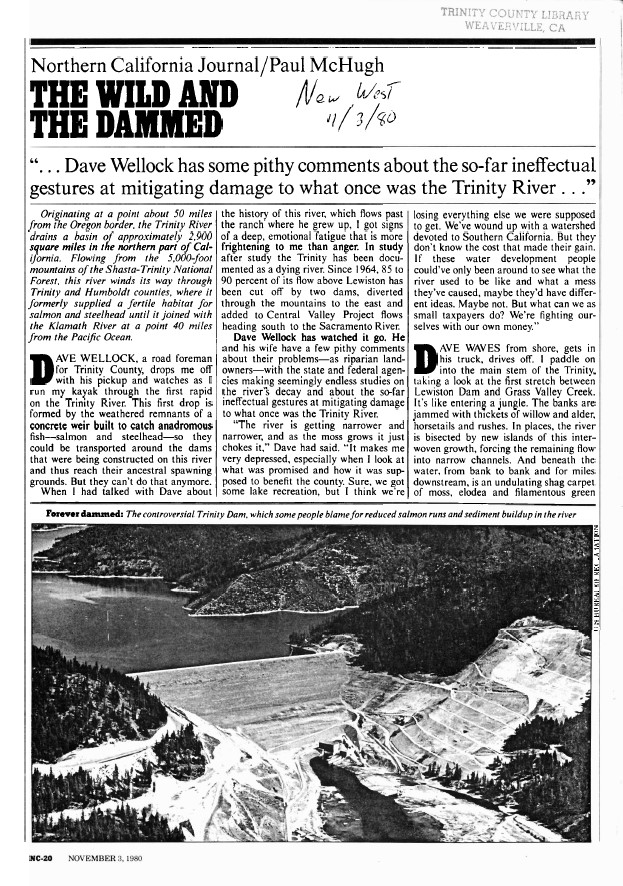
Amaze your river friends by introducing them to the hyporheic zone, an important area where shallow groundwater and surface water mix to support a rich biological habitat of microvegetation that in-turn supports a diverse assemblage of benthic macroinvertebrates, the primary food source for juvenile and adult salmon.
Not only is the hyporheic zone an area that supports great biodiversity, in a 2005 study this zone was also coined the “river’s liver” from findings that carbon and nitrogen cycling in the river was “controlled by the live sediments of the central river channel, which thus represent a “liver function” in the river’s metabolism.”[1] So, the hyporheic zone acts as a filtering mechanism for the river, and an area of rich biodiversity. But that’s not all!
The hyporheic zone provides a multitude of functions and it is critically important to the health of our waterways. Because the hyporheic zone acts as a filtration system through its porous sediments, it also promotes higher levels of dissolved oxygen through photosynthesis. Dissolved oxygen in waterways support anadromous fish species like chinook, steelhead and coho salmon by helping them to maintain a healthy respiratory function.
When Trinity River salmon return to spawn, they dig redds (or nests) to lay their eggs in. The female fish flaps her tail sideways into the river bed, digging down around 12″ to 14″ into the hyporheic zone. After the eggs are laid and fertilized, she covers them with rocks. These rocks protect the eggs and newly hatched alevin from predators. The eggs location in the hyporheic zone provides water flow that flushes metabolic wastes during egg development and provide dissolved oxygen for her embryos to breathe.
The presence of dissolved oxygen, protection from predators, and microvegetation for food makes the hyporheic zone a biologic hotspot for macroinvertebrates. While the insects nestle down in between rocks they feed on leaves, algae, and twigs. In a healthy hyporheic zone where flow and sediments are correctly combined the area supports an abundance of food for the macroinvertebrates which in turn supports an abundance of food for juvenile and adult salmon. And that’s not all! Due to the interaction with upwelling cooler ground water, hyporheic zones help to moderate stream temperatures during the lower flow summer and fall months.
The Significance of the Hyporheic in the Trinity River
The hyporheic zone covers the entire streambed and bank areas of a river bottom and the ability to perform its natural functions are influenced by many things. Some influences include whether the stream is straight or meanders, if there are any obstacles in the channel, such as log, boulder, or even the pier support for a bridge. Factors also include whether the stream has a single channel or multiple channels, and also how porous the streambed sediments are. For example, near Lewiston Dam where there are very few fine sediments, large amounts of the river’s flow go subsurface because they are conveyed in the hyporheic zone. This is an unnatural situation because the river requires all sized sediments, from sand and silt up to cobbles and boulders. So while semi-open pore spaces in the bed are desirable, if the pore spaces are fully open do to the lack of fines in the bed, salmon eggs will jiggle around in redds and die from abrasion as well as the speed of flow between rocks in the hyporheic zone will be too fast for microvegetation to grow and macroinvertebrates to live.

It might be easy to surmise that due to the two dams on the Trinity River, that the hyporheic zone (within the 40-mile restoration reach) lacks diversity. Of course, dams block sediments, nutrients, logs and water from a river’s lower reaches. In a healthy river system, these elements work together to form a river’s structure. It is interesting to note that from 1964-1994 the Trinity River received a year-round baseflow of 200 cubic feet per second. The effect of static water releases was detrimental to the form and function of the river – greatly impacting the hyporheic zone. With the blockage of water, sediments, and logs the river began to stagnate – check out this article from November 3, 1980, “The Wild and the Dammed” where author P. McHugh documents his kayak adventure down the Trinity River in Lewiston.
Thus, to combat a static river system, since 2000, the Trinity River Restoration Program has focused efforts around replenishing the critical building blocks of a river. This is achieved by gravel additions in the upper river, large wood placements along river banks and a yearly spring snowmelt hydrograph that is released from Lewiston Dam. Also, since the Trinity was heavily impacted by hydraulic and dredge mining the program allocates funds for watershed restoration and gives great attention to the diversification of channels and floodplains with mechanical rehabilitation.
These things combined help the dammed Trinity in healing itself, however, many gains are yet to be made with restoration and management. For example, Todd Buxton, PhD, is starting a three year study of the hyporheic zone in the Trinity River. The study will construct a mathematical model to simulate the flow rates and directions, temperatures, and dissolved oxygen in the hyporheic zone. At the same time, macroinvertebrates in the hyporheic zone will be measured where the study is being conducted at sites within the 40-mile restoration reach. This information will be used to develop a statistical model for predicting the density and species composition of macroinvertebrates based on the above characteristics in the hyporheic zone, since these aspects have a strong role in determining how many and what species of macroinvertebrates may be present. Application of the paired models will then enable scientists to better understand how surface flows and temperatures in the river can be better managed to promote macroinvertebrate populations and increase the availability of food for salmon.
Additionally, the program has made significant gains with increases in outmigrating salmon smolts since 2000, but these fish are not returning home at the rates that were observed before this year. Scientist have identified that the Program’s current management of flow timing could be a critical limiting factor for the fish of the Trinity River. If juvenile fish had more food available to them when they are emerging from their nests they may enter the ocean more robust. If elevated flows from the dam are timed with winter storms, then the Trinity River could add to the power of the tributary flows to increase mainstem water levels to prevent delta creation while simultaneously preventing sediments from smothering redds and other important living organisms within the hyporheic zone.
Understanding this unique area has been a challenge for river scientists because the hyporheic function is expansive. It is also unique to each river system and crosses over many scientific disciplines. The zone not only intrigues those interested in studying the microbiome of a river system, but also includes; ecologists, geomorphologists, hydrologists and environmental engineers, just to name a few. With each discipline and study within, scientists learn more and more about the fascinating world that exists beneath and alongside a river’s bed and how river restorationists can better understand to allow it to flourish.
References
Lewandowski, J.; Arnon, S.; Banks, E.; Batelaan, O.; Betterle, A.; Broecker, T.; Coll, C.; Drummond, J.D.; Gaona Garcia, J.; Galloway, J.; et al. Is the Hyporheic Zone Relevant beyond the Scientific Community? Water 2019, 11, 2230. https://doi.org/10.3390/w11112230
The Significance of the Hyporheic Zone, Jana Hemphill, Deschutes Land Trust, 2021.
